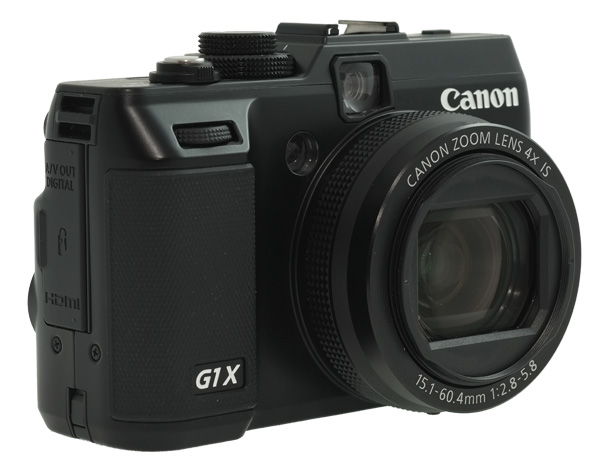The Canon Powershot G1 X is currently the top-of-the-line fixed lens camera from Canon. The 1 in the name represents a fresh start for the G-series which has existed for a long time. They had G12, G11, G10, G9 and many more before that, skipping only a few digits in the series. From the start, these cameras were designed as advanced models with full manual controls and a good number of buttons and dials for efficiency. The series quickly became popular among photographers looking for a camera to use when they didn’t have their professional gear.
Yet one day, August 19th, 2009, the Canon G-series made sense no more. Canon had launched the Powershot S90. The S90 took exactly the same sensor as the G11 and put it behind a fast F/2 lens in a smaller body with dual control-dials. In doing so, they let the S90 produce better images than the G11 by shooting at a lower ISO and even more efficiently at that, since the G11 only had one control-dial. The S90 did lose the hot-shoe of the G-series but people rarely use flashes with such a small camera. After all, most add-on flashes are heavier than the camera and if you are carrying big heavy stuff, you probably have a corresponding camera with you too.  Then, on January 9th, 2012, Canon unveiled the G1 X, doing the one thing that cannot be reproduced in the smaller S-series: They fitted the G1 X with a relatively huge 1.5″ CMOS sensor. The newly designed 14 MP sensor is between the size of a Four-Thirds and APS-C sensor, giving the potential for truly high-quality images.
Then, on January 9th, 2012, Canon unveiled the G1 X, doing the one thing that cannot be reproduced in the smaller S-series: They fitted the G1 X with a relatively huge 1.5″ CMOS sensor. The newly designed 14 MP sensor is between the size of a Four-Thirds and APS-C sensor, giving the potential for truly high-quality images.
Before getting to how it performs, a few words about its usability. The Canon Powershot G1 X is joy to use. Its a simple camera which behaves in the expected way most of the time. The traditional mode-dial, dual control-dials and even EC dial makes things very easy and unsurprising. Dial the exposure mode you want and use the front control-dial to set the main exposure parameter. In Manual mode, use the rear control-dial to set the second parameter, usually shutter-speed but that is configurable. The only time a dial gets overloaded is when in Manual exposure-mode and in Manual focus mode. In this case, the rear dial serves dual functions and so does the metering button which serves to switch between controlling the secondary exposure parameter and the focus distance.
For setting the ISO, there is the Up direction of the 4-way controller and for setting EC, there is a dial underneath the mode-dial. Each are straight forwards. The only other two key functions I regularly use are the self-timer and white-balance. Those are accessible via Canon’s classic Function menu which is relatively efficient to use. One of these functions can be assigned to the customizable Shortcut button but the G1 X has something else which is interesting to put there… a built-in 3-stop ND filter. ND filters allow longer shutter-speeds to be used to get motion blur and light trails. Here is a 60s exposure with the ND filter enabled.
So, overall the G1 X is quite intuitive and easy to use. Having a zoom lens, as opposed to a fixed prime lens as other large-sensor compacts, also allows a lot of framing flexibility. There are some nitpicks which could be improved in terms of ergonomics but nothing really serious.
Image quality is the first thing we judge cameras by and the Canon Powershot G1 X really excels at it. Good quality was certainly expected given the sensor size but I am surprised of how good it is. Without a doubt, the G1 X produces completely usable results until ISO 3200. There is some noise visible there and some at ISO 1600 too but it is on the same level as a top-of-the-line cropped-sensor (APS-C) DSLR. There is obvious noise at ISO 6400 but nothing which would show in a small-to-medium size print. Even ISO 12800 produces some nice 4″ x 6″ prints, actually 4″ x 5 1/3″ because the G1 X has a 4:3 aspect-ratio instead of the usual 3:2 ratio of most DSLRs.
Image quality is more things than noise and the G1 X manages well in other areas. Shooting RAW it is possible to overcome some issues since the JPEG engine is not great at color-accuracy and auto white-balance leaves the occasional bluish cast in low-light and yellow or magenta cast under artificial light. One area where it could be improved is in terms of exposure. The Evaluative meter blows highlights more often than I would like. This is somewhat a personal choice but it means moving the EC dial towards the negative side more often than I am used to. One trick is to use the AE-L (*) button to lock an exposure with more bright areas which cause the meter to chose a darker exposure. This was my preference over EC since AE-L is reset after each shot.
The one area where the G1 X is behind cameras in the same price range is autofocus performance. In good light and towards the wide-end of the zoom, there is really not much to complain about. However, in low-light it gets quite slow. It also gives up focusing more than a typical compact. Zoom in towards the telephoto end and autofocus in low light constantly takes over 1s which is way too long for moving subjects. It is obvious that the dim F/5.8 maximum aperture at the long end has something to do with it but also the large sensor which requires much more precise focusing than the average compact digital camera.
Overall all, the Canon Powershot G1 X is impressive. Image quality is truly excellent. Plus, the camera is simple to use and intuitive. The zoom range is good for a variety of subjects. For moving subjects and obviously action photography, I certainly have some reservations but for general travel and day-to-day photography it is a great way to avoid carrying a bulky DSLR plus lenses around. As always, whether this is the right camera depends on your needs but Canon clearly has an winner with the G1 X.
PS: A gallery of full-resolution Canon Powershot G1 X images should be available on my site towards the end of next week.
Filed under PhotoSE Gear Grant



Subscribe to comments with RSS.
Comments have been closed for this post